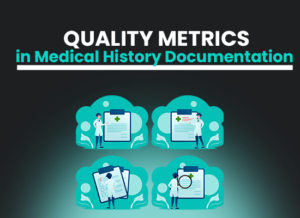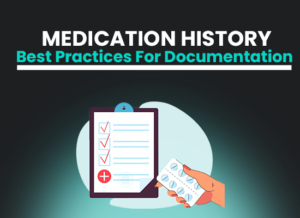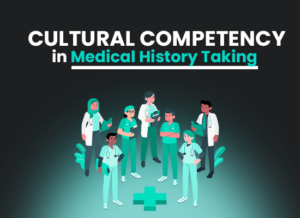What is a Medical Scribe? Know How to Keep Your Doctors Away from Keywords for Good
- October 17, 2024
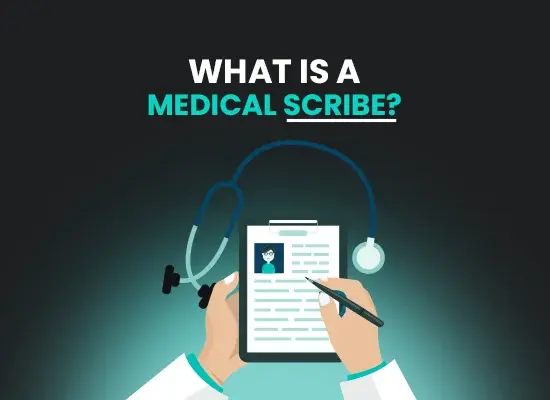
Table of Contents
A medical scribe plays a vital role in healthcare settings, helping to streamline documentation and improve patient care. They assist physicians by managing electronic health records and capturing detailed patient information during visits.
Medical scribes differ from Smart Medical History. Smart Medical History’s AI-powered medical software goes beyond facilitating engaging dialogues—it captures nuance, context, and the full depth of patient narratives. Our platform transforms interviews into meaningful, comprehensive medical histories, providing far more than passive transcription or basic report generation. It actively analyzes interactions to deliver rich, actionable insights that drive better care and understanding.AI In this discussion, we will focus on medical scribes, a more passive approach than the proactive approach with Smart Medical History.
Medical Scribes allows doctors to focus more on patients rather than getting bogged down by administrative tasks. In this post, we’ll explore the responsibilities, benefits, and skills of medical scribes. Get ready to dive into the world of medical scribes and discover how they make a difference every day.
Key Takeaways:
- A medical scribe is a professional or a technology that assists healthcare providers by documenting patient interactions and medical information, allowing doctors to focus more on patient care.
- AI medical scribes are becoming popular as they can efficiently handle documentation, saving time and reducing the administrative burden on healthcare staff.
- When choosing the best AI medical scribe, consider factors like accuracy, user-friendliness, and integration with existing systems to enhance workflow.
- AI medical documentation tools can streamline record-keeping, making it easier for healthcare professionals to access and manage patient data.
- Understanding the costs associated with AI medical scribes and transcription software is crucial for budgeting in healthcare settings.
- Reading reviews of AI medical scribe software can help you make informed decisions about which tools will best meet your practice’s needs.
What is a Medical Scribe?
Did you know that over 80% of doctors feel overwhelmed by paperwork? This is where a medical scribe comes in. Medical scribes play a vital role in healthcare. They assist physicians by documenting patient encounters. This allows doctors to focus more on patient care. Scribes handle the electronic health records (EHR) and other paperwork. They ensure that all necessary information is recorded accurately.
Typically, medical scribes work in hospitals, clinics, and private practices. They follow the physician during patient visits. As patients discuss their symptoms, scribes take notes. This process helps create a detailed record of each visit. It also enhances communication between healthcare providers.
In recent years, the demand for medical scribes has increased. More healthcare facilities recognize their importance. The Bureau of Labor Statistics (BLS) reports that the median annual salary for a medical scribe is over $30,000. This makes scribing an excellent entry point into the medical field.
Try it - Love it - Buy it
Avail Our Free Trial Now!

What is a Medical Scribe Used For?
Medical scribes have specific responsibilities in modern healthcare settings. On a typical day, physicians see around 20 to 35 patients. These patients may require various services. This includes routine check-ups, urgent care visits, and pre-op or post-op consultations.
Scribes support doctors during these busy days. They document patient histories, physical exams, and treatment plans. By handling these tasks, scribes allow physicians to spend more time with their patients. This can lead to better patient outcomes and satisfaction.
Scribes help maintain accurate records. Proper documentation is crucial for effective patient care and billing purposes. Accurate records also support continuity of care among different healthcare providers.
Having a medical scribe offers several benefits to clinical settings. Firstly, it improves efficiency in the office or hospital. Physicians can see more patients without sacrificing quality care. Scribes manage the paperwork while doctors focus on diagnosis and treatment.
Secondly, it enhances the accuracy of medical records. When scribes document encounters in real-time, fewer errors occur. This reduces the chances of miscommunication among staff members.
Lastly, employing a medical scribe can lead to higher job satisfaction for physicians. Doctors often express frustration with administrative tasks. By delegating these duties to scribes, they can concentrate on what they do best—caring for patients.
AI Medical Scribe:
AI Medical Scribe: An Overview
AI medical scribes are changing how healthcare operates. They help reduce the burden of documentation for doctors. A recent study found that 79 percent of physicians would see more patients if they had scribe support. This shows how much scribes can help in a busy medical environment.
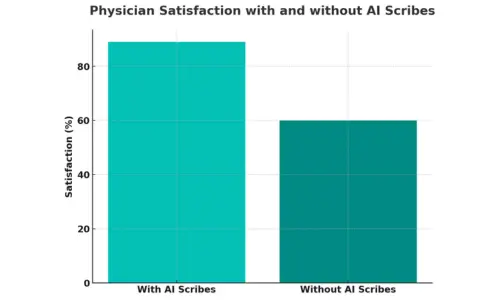
Many physicians across the country are turning to medical scribe services. These services allow doctors to focus more on patient care and less on paperwork. The use of AI technology makes this process even smoother. Smart Medical History AI, an AI medical history tool provides efficient proactive solutions perform medical interviews and provide analysis. The result is provided in a detailed report.
AI medical scribes not only take notes but also ensure accuracy in documentation. They can quickly record vital information during patient visits. This allows doctors to spend more time interacting with their patients, which improves overall satisfaction.
How AI Medical Scribe Enhances Healthcare Efficiency?
AI medical scribes enhance healthcare efficiency significantly. They streamline communication between departments. For example, if a patient needs an X-ray or blood test, the scribe ensures that all necessary information is relayed promptly.
Scribes also help manage electronic health records (EHR). They input data accurately while maintaining patient confidentiality. This reduces errors that might occur if doctors were to enter data themselves while focusing on the patient.
The ability to multitask is crucial for a medical scribe. They often handle various responsibilities simultaneously. From documenting patient encounters to coordinating tests, their role is vital in a fast-paced environment.
AI Medical Scribe Workflow Cycle:
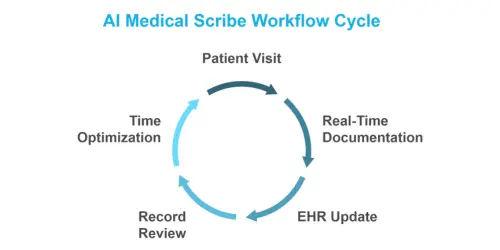
The AI Medical Scribe Workflow Cycle outlines the critical steps taken by an AI scribe during patient interactions. Starting with a patient visit, the AI scribe captures real-time documentation, updates electronic health records (EHR), and ensures physicians can review records promptly. This process not only saves time but also improves the accuracy of patient information and overall care. Through optimized time management, healthcare providers can focus more on patient engagement and less on administrative tasks, significantly enhancing operational efficiency.
The Future of AI Medical Scribe in Medicine:
The future of AI medical scribes looks promising. As technology advances, these tools will become even more integrated into healthcare systems. More hospitals and clinics will likely adopt AI scribes to improve workflow.
With AI’s growing capabilities, scribes could automate routine tasks further. This would free up even more time for physicians to concentrate on patient care. Enhanced data analysis could also provide insights into patient health trends over time.
Training programs for aspiring medical professionals may include training on using AI scribes. This will ensure that future doctors are well-prepared for modern healthcare demands. Understanding how to work with AI tools will be crucial in their careers.
Best AI Medical Scribe:
Smart Medical History AI stands out in the field of medical scribing since it is a proactive approach, rather than a passive listening approach. Their AI medical chatbot offers innovative solutions for healthcare providers. This technology helps streamline documentation tasks. It reduces the burden on healthcare professionals, allowing them to focus more on patient care.
AI Solutions Enhancing Medical Scribe Efficiency:
As the demand for medical scribes rises, companies like Smart Medical History offering a more powerful
solution are making a significant impact. Their AI chatbot assists in capturing patient information efficiently. This technology allows scribes to manage their time better. They can handle more patients without compromising quality.
Best AI Medical Scribe Software Solutions:
Various software solutions support medical scribes today. These tools help automate routine tasks and improve accuracy in documentation. Smart Medical History AI is a unique solution compared to passive systems.
Software should integrate seamlessly into existing workflows. It captures data in real-time during patient visits. By doing so, it minimizes errors associated with manual data entry.
Other notable companies in this space include Amazon, M*Modal and Nuance Communications. Both offer advanced speech recognition technology for medical documentation. These solutions are designed to enhance efficiency in healthcare settings.
AI Medical Scribe Reviews: What Do Users Say?
User reviews for Smart Medical History AI show positive feedback. Many users appreciate the ease of use and efficiency of the platform. They highlight how the AI interview process simplifies the documentation process.
Testimonials indicate that healthcare providers feel less stressed when using this service. One user mentioned that they could see more patients without feeling overwhelmed by paperwork. Another noted that the accuracy of patient records improved significantly after adopting Smart Medical History AI.
The feedback reflects a growing trend among healthcare professionals seeking reliable scribe services. As more providers adopt AI-based solutions, the landscape of medical scribing will continue to evolve.
AI Medical Documentation:
AI Medical Documentation: What You Need to Know?
Accurate and quick typing are essential skills for medical scribes. They must also multitask effectively. These skills help them keep up with the fast pace of healthcare environments. Initially, medical scribes mainly assisted in the transition from paper records to digital formats. This change was crucial for improving record-keeping efficiency. However, their roles have expanded significantly in recent years. Now, they often work alongside artificial intelligence (AI) systems.
AI has transformed how medical documentation is handled. With AI tools, scribes can quickly input patient information and notes during visits. This technology reduces the time spent on paperwork. It allows healthcare providers to focus more on patient care. Studies show that AI scribes can save doctors an hour each day. This extra time can lead to better patient interactions and improved care quality.
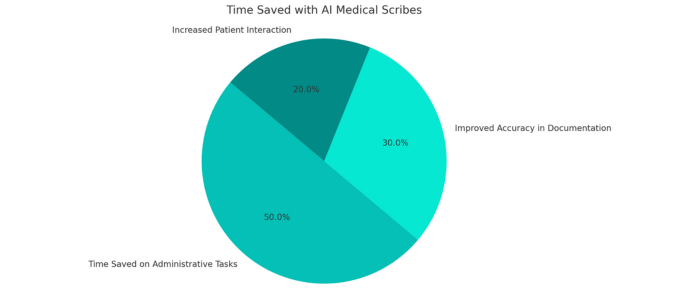
AI also helps ensure accuracy in documentation. By using voice recognition and natural language processing, these systems minimize errors. This technology captures details that might be missed during manual entry. As a result, patient records become more reliable and comprehensive. The integration of AI into medical documentation is changing the landscape of healthcare.
Advantages of AI Medical Documentation in Healthcare:
The benefits of AI medical documentation are significant. First, AI reduces the documentation burden on physicians. Many studies support this claim, including one by Kaiser Permanente. Researchers found that using scribes improves efficiency in healthcare settings. This efficiency leads to smoother workflows and better communication between patients and doctors.
Second, AI documentation enhances patient-physician interaction. With less time spent on paperwork, doctors can engage more with their patients. This engagement fosters trust and satisfaction among patients. When patients feel heard and understood, they are more likely to follow treatment plans.
Third, implementing AI solutions can lower operational costs for healthcare practices. Less time spent on documentation means more patients can be seen in a day. Increased patient volume often leads to higher revenue for practices without compromising care quality.
Implementing AI Medical Documentation in Your Practice:
Implementing AI medical documentation requires careful planning and training. Certifications such as the Certified Medical Scribe Professional are available through organizations like the American Healthcare Documentation Professionals Group. These certifications ensure that scribes possess the necessary skills to use AI tools effectively.
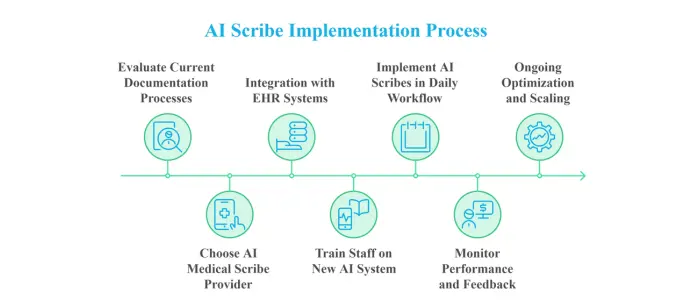
Training staff on new technologies is crucial for success. A well-trained team will adapt faster to changes in workflows. They will also be better equipped to utilize AI tools efficiently. Regular updates and ongoing education keep teams informed about the latest advancements in medical documentation.
Healthcare providers should also evaluate their current systems before integrating AI solutions. Understanding existing workflows helps identify areas that need improvement. This evaluation ensures that the implementation process runs smoothly and meets specific practice needs.
AI Medical Transcription:
AI Medical Transcription: An Introduction
AI medical transcription involves using artificial intelligence to convert spoken words into written text. This technology assists healthcare professionals in documenting patient information quickly and accurately.
AI tools analyze audio recordings from doctor-patient interactions. They recognize speech patterns and convert them into text format. This process can save time and reduce errors in documentation.
The rise of telemedicine increased the need for efficient transcription methods. In 2020, many healthcare providers shifted to virtual visits due to the COVID-19 pandemic. AI medical transcription emerged as a solution to manage the growing volume of patient encounters.
Benefits of AI Medical Transcription Over Traditional Methods:
AI medical transcription offers several advantages compared to traditional methods. First, it significantly reduces the time required for documentation. Healthcare professionals can focus more on patient care rather than paperwork.
Second, accuracy improves with AI technology. Traditional transcription often relies on human input, which can lead to mistakes. AI systems learn from previous data and continually improve their performance. This results in fewer errors in medical records.
Third, cost savings are another benefit. Hiring human transcribers can be expensive and time-consuming. AI solutions require a one-time investment or subscription fee but can handle large volumes of work efficiently.
Lastly, accessibility increases with AI medical transcription. Providers can access transcriptions from anywhere, thanks to cloud-based systems. This allows for better collaboration among healthcare teams.
Best AI Medical Transcription Software Options:
Several AI medical transcription software options exist today. Each has unique features that cater to different needs.
1- Dragon Medical One:
This software is popular among healthcare providers. It offers voice recognition tailored for medical terminology. Users appreciate its speed and accuracy.
2- M*Modal Fluency:
M*Modal provides a comprehensive platform that integrates with electronic health records (EHR). Its advanced AI capabilities help streamline documentation processes.
3- Nuance PowerScribe:
Designed specifically for radiology, this software enhances reporting efficiency. It allows radiologists to dictate reports easily and accurately.
4- ScribeCare:
This tool focuses on providing real-time documentation support during patient visits. It helps clinicians capture important information without distraction.
5- Ambra Health:
Ambra Health’s platform simplifies image management alongside transcription services. It serves healthcare organizations that require both imaging and documentation solutions.
Each of these tools has pros and cons, depending on user preferences and specific needs.
AI Medical Charting:
AI Medical Charting: What It Is and How It Works?
AI medical charting uses technology to streamline the process of documenting patient information. This system analyzes data from various sources, like electronic health records (EHRs) and notes from healthcare providers.
The software can pull in patient history, medications, and even lab results. It organizes this information into a clear, concise format. With AI, the time spent on paperwork decreases significantly. This allows healthcare professionals to focus more on patient care.
AI medical charting works by utilizing algorithms. These algorithms recognize patterns in data. They help create accurate and detailed patient records automatically. For example, if a doctor inputs a diagnosis, the AI can suggest relevant treatments based on past cases. This capability enhances decision-making for healthcare providers.
How AI Medical Charting Improves Patient Records Accuracy?
Accuracy is essential in patient records. Errors can lead to serious consequences for patients. AI medical charting minimizes these risks by ensuring that data is recorded correctly and consistently.
One way AI improves accuracy is through real-time updates. As soon as a healthcare provider enters new information, the system updates the patient’s record instantly. This feature helps avoid outdated or incorrect data.
AI also reduces human error. Traditional methods rely heavily on manual input, which can lead to mistakes. By automating data entry, AI significantly lowers the chances of errors occurring. For instance, if a nurse mishears a medication dosage, the AI checks against standard dosages to flag potential mistakes.
Furthermore, AI systems can analyze large amounts of data quickly. They identify discrepancies or unusual patterns in patient records that may need attention. This function ensures that any issues are addressed promptly.
Integrating AI Medical Charting into Your Healthcare System:
Integrating AI medical charting requires careful planning and execution. First, healthcare facilities need to assess their current systems. Understanding existing workflows is crucial for smooth integration.
Next, staff training plays an important role. All team members must understand how to use the new system effectively. Training sessions should cover basic functions and troubleshooting techniques.
Healthcare organizations must also ensure compatibility with current EHR systems. The new AI tools should seamlessly fit into existing workflows without causing disruptions.
After implementation, ongoing evaluation is necessary. Regular assessments help identify any areas needing improvement. Feedback from users can guide further enhancements to the system.
AI Medical Scribe Companies:
Smart Medical History is gaining interest among large enterprise. This company uses advanced technology to streamline medical documentation. They focus on improving efficiency and accuracy in patient records.
Many healthcare providers struggle with the burden of paperwork. Smart Medical History offers a solution. Their AI-driven platform reduces the time spent on charting. This allows healthcare professionals to focus more on patient care.
The integration of AI in scribing helps minimize errors. It also speeds up the documentation process. Large enterprises appreciate these benefits. They can enhance productivity while ensuring high-quality patient records.
According to a 2023 survey by Elation, 1 in 3 primary physicians have tried AI scribe tools and 83% anticipate reduced documentation burden and 89% anticipate better job satisfaction.
AI Medical Scribe Companies: Leading the Way
AI medical scribe companies are changing how healthcare documentation is done. These companies employ artificial intelligence to assist human scribes or operate independently. They provide real-time data entry during patient visits.
Several key players lead this sector. Companies like Smart Medical History, M*Modal, and ScribeAmerica have made significant impacts. They offer various features tailored to different healthcare settings.
AI technologies have improved significantly over recent years. The ability to understand natural language is one major advancement. This allows AI systems to accurately capture physician-patient conversations.
Healthcare providers benefit from these innovations. They can reduce administrative burdens and improve workflow efficiency. As a result, patient satisfaction often increases as well.
How to Choose the Right AI Medical Scribe Company for Your Needs?
Choosing an AI medical scribe company requires careful consideration. Start by evaluating your specific needs. Different practices may require different features and capabilities.
1- Assess Your Practice Size:
Larger practices may need more robust solutions compared to smaller ones.
2- Consider Integration:
Ensure the company’s system integrates smoothly with existing software.
3- Evaluate Accuracy:
Check reviews and testimonials regarding accuracy rates.
4- Look for Support Services:
Good customer support is essential for troubleshooting issues.
5- Review Pricing Models:
Compare costs and ensure they fit your budget.
Selecting the right company can greatly impact your practice’s efficiency. A good partnership leads to better patient care and smoother operations.
Comparing AI Medical Scribe Companies: Features and Benefits
When comparing AI medical scribe companies, focus on their features and benefits. Each company offers unique tools that cater to different needs.
- Smart Medical History is a proactive approach that focuses on AI driven interviews and detailed analysis.
- M*Modal provides advanced speech recognition capabilities.
- ScribeAmerica offers flexible staffing solutions for various settings.
Key benefits include:
- Time Savings: Reducing documentation time allows for more patient interaction.
- Enhanced Accuracy: AI helps minimize human errors in medical records.
- Cost Efficiency: Automating tasks can reduce overhead costs in the long run.
Understanding these features helps healthcare providers make informed decisions. It ensures that they select a service that aligns with their operational goals.
Did you Know? Considering physicians now spend up to twice as much time completing electronic documentation and administrative tasks (50%) as time engaging in direct bedside patient care (12%–27%), it is not surprising that surgeon discontent has reached an all-time high.
| AI Scribe Service | Pricing Model | Key Features | Website |
|---|---|---|---|
| Smart Medical History | Subscription-based | Proactive strategy with AI-driven multilingual and data sophisticated data analysis. | smartmedhx.ai |
| AWS HealthScribe | Pay-per-use | E-powering healthcare software vendors to build clinical applications that automatically generate preliminary clinical notes by analyzing patient-clinician conversations. | aws.amazon.com/healthscribe/ |
| ScribeAI | Pay-per-use | Voice recognition, real-time transcription, multi-specialty support | scribeai.com |
| Rev | Pay-per-minute | Audio transcription, captioning services, high accuracy | rev.com |
| Scribekick | Monthly subscription | AI-driven notes, patient engagement tools, analytics dashboard | scribekick.com |
| Notedown | One-time fee | Manual and AI-assisted transcription, secure data handling | notedown.com |
| MedScribe | Annual subscription | EHR integration, customizable workflows, patient note generation | medscribe.ai |
AI Medical Transcription Software:
AI medical transcription software helps healthcare professionals document patient interactions efficiently. This technology uses artificial intelligence to convert spoken language into written text. It saves time and reduces errors in documentation.
AI Medical Transcription Software: An Overview
AI medical transcription software has changed how medical records are created. Traditional methods often required manual typing by staff or scribes. This process was slow and prone to mistakes. With AI, the software listens to conversations and transcribes them instantly.
In 2020, the global market for medical transcription services was valued at about $2 billion. Experts predict it will grow significantly in the coming years. The rise of telemedicine and electronic health records drives this growth. Providers need accurate documentation more than ever.
Smart Medical History is one example of an advanced AI medical transcription service. It offers features that streamline the transcription process. Users can easily access their notes and manage patient information without hassle.
Key Features to Look for in AI Medical Transcription Software
When choosing AI medical transcription software, several key features stand out.
1- Accuracy:
The software should provide high accuracy levels. Look for systems that have proven track records.
2- Integration:
Seamless integration with existing electronic health record systems is crucial. This ensures that all data flows smoothly between platforms.
3- User-Friendly Interface:
A simple interface makes it easy for users to navigate the software. This reduces training time and increases productivity.
4- Customization Options:
Different medical practices have unique needs. Customizable templates help ensure that the software meets specific requirements.
5- Security Measures:
Patient data must be protected at all costs. Choose software that complies with HIPAA regulations.
6- Support Services:
Reliable customer support is essential for troubleshooting issues quickly.
By focusing on these features, healthcare providers can select the best AI medical transcription software for their needs.
Top AI Medical Transcription Software Reviews:
Several AI medical transcription software options are available today, each with its strengths and weaknesses.
1- Smart Medical History:
This platform stands out for its user-friendly design and strong accuracy rates. It integrates well with various electronic health record systems, making it a popular choice among practitioners.
2- Nuance Dragon Medical One:
Known for its powerful voice recognition capabilities, this software is widely used in hospitals and clinics. It allows users to dictate notes directly into their EHRs, saving time.
3- MediScribe:
This option focuses on providing affordable solutions without sacrificing quality. It offers flexible pricing plans suitable for small practices.
4- eScribe:
eScribe excels in its customization options, allowing practices to tailor the software to their needs easily.
5- TranscribeMe:
While not specifically designed for healthcare, it provides reliable transcription services across various fields, including medicine.
Each of these platforms has unique features that cater to different practice types and sizes.
AI Medical Scribe Cost:
AI Medical Scribe Cost: What to Expect?
AI medical scribes have become popular in healthcare settings. They help doctors document patient visits quickly and accurately. The cost of using these services can vary widely. On average, organizations may spend between $1,000 to $3,000 per month for an AI medical scribe service.
Some companies offer pay-per-use models. Others provide subscription plans with monthly fees. Pricing often depends on the features included in the service. For instance, advanced features like voice recognition or integration with electronic health records (EHR) may increase costs.
Healthcare providers should consider these costs carefully. Budgeting for an AI medical scribe is essential for effective financial planning. It’s also important to factor in potential savings from increased efficiency and reduced administrative workload.
Small to mid-sized healthcare providers should consider this approach. Implementing AI-powered healthcare chatbots is not just for large hospitals. These solutions are accessible and beneficial for all practice sizes. The ease of use and increased efficiency make them appealing options for any clinic.
Factors Influencing AI Medical Scribe Cost:
Several factors affect the cost of AI medical scribes. First, the size of the healthcare practice plays a significant role. Larger practices typically require more extensive services, which can drive up costs.
Second, the complexity of services needed matters. Basic transcription services are less expensive than comprehensive solutions that include real-time documentation and data analysis. Providers must assess their specific needs before choosing a service.
Third, the level of customization impacts pricing. Some AI scribes offer tailored solutions to fit unique workflows. Customization can lead to higher costs but may improve overall efficiency.
Finally, the vendor’s reputation and experience influence pricing as well. Established companies with proven track records often charge more due to their reliability and quality of service.
Cost-Benefit Analysis of Implementing AI Medical Scribe:
Conducting a cost-benefit analysis is crucial before investing in an AI medical scribe. This analysis helps healthcare providers weigh the expenses against potential benefits.
1- Increased Efficiency:
AI scribes save time during patient visits. Doctors can focus on patient care rather than paperwork.
2- Reduced Errors:
Automated documentation reduces human errors in recording information. This leads to better patient outcomes and fewer legal issues.
3- Improved Patient Satisfaction:
Patients appreciate shorter wait times and more focused interactions with their doctors.
4- Long-term Savings:
While initial costs may be high, long-term savings can outweigh expenses through improved workflow and reduced staffing needs.
5- Scalability:
As practices grow, AI scribes can adapt without needing significant changes to staff or processes.
| Cost Factor | Description | Estimated Cost |
|---|---|---|
| Initial Development | Cost of hiring developers, designers, and project managers. | $50,000 – $200,000 |
| Technology Stack | Expenses for software licenses, frameworks, and tools. | $10,000 – $50,000 |
| Data Acquisition | Costs related to acquiring medical datasets for training. | $5,000 – $30,000 |
| Compliance and Legal Fees | Ensuring HIPAA compliance and other legal requirements. | $5,000 – $20,000 |
| Testing and Quality Assurance | Costs for testing the software to ensure accuracy and reliability. | $10,000 – $40,000 |
| Maintenance and Updates | Ongoing costs for software maintenance and feature updates. | $2,000 – $10,000 annually |
| User Training and Support | Costs associated with training users and providing customer support. | $5,000 – $15,000 |
| Marketing and Launch | Expenses for marketing campaigns and product launch events. | $10,000 – $50,000 |
| Total Estimated Cost | Aggregate of all costs involved in development. | $97,000 – $415,000 |
Why Smart Medical History AI is a Superior Solution to Developing In-House AI Medical Scribes?
Medical scribes play a pivotal role in enhancing clinical efficiency by accurately recording patient interactions. However, organizations face a critical decision: should they invest in developing their own AI medical scribe systems, or opt for a proactive and ready-made solution like Smart Medical History AI?
Explores why Smart Medical History AI stands out as a better solution compared to the substantial investment required for in-house development:
Cost Efficiency:
One of the most compelling reasons to choose Smart Medical History AI over developing an in-house AI medical scribe is the significant cost savings involved.
Total Development Cost: $97,000 – $415,000
Smart Medical History AI Pricing Plans:
- Essential: $117/month (~$1,404/year) – Up to 3 Histories per month
- Standard: $277/month (~$3,324/year) – Up to 8 Histories per month
- Intermediate: $427/month (~$5,124/year) – Up to 15 Histories per month
- Advanced: $747/month (~$8,964/year) – Up to 30 Histories per month
Annual Cost Comparison:
- In-House Development: $97,000 – $415,000 (initial) + $2,000 – $10,000 (maintenance)
- Smart Medical History AI: $1,404 – $8,964 annually
Subscribing to Smart Medical History AI offers a fraction of the cost required to develop and maintain an in-house AI medical scribe system, making it a highly cost-effective solution for healthcare practices of all sizes.
Time to Implementation:
Smart Medical History AI provides an immediate, out-of-the-box solution, allowing healthcare providers to integrate AI-driven medical documentation without the lengthy development process.
In-House Development Timeline:
- Hiring and Team Assembly: Several months
- Development and Testing: 6-12 months or longer
- Compliance and Legal Setup: Concurrent with development
- Training and Deployment: Additional weeks to months
- Total Time to Implementation: 9 months – 2 years
Smart Medical History AI Implementation:
- Subscription Setup: Within days
- Integration and Training: Minimal time with dedicated support
- Total Time to Implementation: Days to weeks
Smart Medical History AI significantly reduces the time required to deploy an AI medical scribe, enabling healthcare providers to benefit from enhanced documentation and operational efficiency almost immediately.
Expertise and Quality Assurance:
Developing an AI medical scribe system in-house requires a high level of expertise in AI, machine learning, natural language processing, and healthcare compliance.
In-House Expertise Requirements:
- Specialized Skills: AI/ML engineers, data scientists, UX/UI designers, compliance officers
- Continuous Learning: Keeping up with advancements in AI and healthcare regulations
- Quality Assurance: Rigorous testing to ensure accuracy and reliability
Challenges:
- Resource Intensive: High demand for specialized talent
- Risk of Inaccuracy: Potential for errors without extensive testing and validation
Smart Medical History AI Expertise:
- Dedicated AI Specialists: Teams focused solely on developing and refining AI medical scribes
- Proven Algorithms: Continuously updated and validated for accuracy and reliability
- Compliance Assurance: Built-in adherence to HIPAA and other legal standards
By choosing Smart Medical History AI, healthcare providers leverage the expertise of dedicated AI professionals, ensuring high-quality, accurate, and compliant medical documentation without the need to build and maintain such capabilities internally.
Scalability and Flexibility:
As healthcare practices grow, their documentation needs can change rapidly. Smart Medical History AI offers scalable solutions that can easily adapt to varying demands.
In-House Development Scalability:
- Resource Allocation: Additional costs and time to scale the system
- Infrastructure Upgrades: Potential need for more servers, software licenses, and support staff
Challenges:
- Limited Scalability: High costs and logistical challenges in scaling up
- Inflexibility: Difficulty in rapidly adjusting to changing requirements
Smart Medical History AI Scalability:
- Flexible Plans: Multiple pricing tiers to match varying documentation needs
- Seamless Upgrades: Easily upgrade or downgrade plans based on current requirements
- Cloud-Based Infrastructure: Automatically handles increased loads without additional costs
Smart Medical History AI provides a flexible and scalable solution that can grow with your practice, ensuring consistent performance and cost-effectiveness regardless of changes in documentation volume.
Compliance and Security:
Maintaining compliance with healthcare regulations is paramount. Developing an in-house AI system requires rigorous adherence to standards like HIPAA.
In-House Compliance Challenges:
- Dedicated Legal Expertise: Necessitates hiring or consulting with legal experts
- Ongoing Audits: Regular compliance checks and updates
- Risk of Non-Compliance: High stakes with potential legal and financial repercussions
Smart Medical History AI Compliance:
- Built-In Compliance: Adheres to HIPAA and other relevant regulations by default
- Regular Updates: Continuous monitoring and updating to meet evolving legal standards
- Secure Infrastructure: Utilizes robust security measures to protect patient data
Smart Medical History AI eliminates the complexities and risks associated with ensuring compliance, providing a secure and legally sound solution for medical documentation.
Maintenance and Support:
Ongoing maintenance and support are crucial for the sustained performance of any AI system.
In-House Maintenance Costs:
- Dedicated IT Staff: Continuous support and troubleshooting
- Software Updates: Regular updates to improve functionality and security
- Customer Support: Establishing a support team for user training and issue resolution
- Costs: $2,000 – $10,000 annually for maintenance plus additional costs for support and updates.
Smart Medical History AI Maintenance and Support:
- Included in Subscription: Maintenance, updates, and support are part of the subscription fee
- 24/7 Customer Support: Access to dedicated support teams for assistance and training
- Automatic Updates: Seamless updates without disrupting operations
Smart Medical History AI provides comprehensive maintenance and support services as part of its subscription plans, ensuring that your system remains up-to-date and reliable without additional costs or resource allocation.
Marketing and Deployment:
Launching and marketing an in-house AI medical scribe system requires significant investment and effort.
In-House Deployment Costs:
- Marketing Campaigns: $10,000 – $50,000 for product launches and promotions
- User Training: $5,000 – $15,000 for training sessions and materials
- Deployment Efforts: Coordinating with various departments for smooth implementation
Smart Medical History AI Deployment:
- Minimal Marketing Required: Leverage Smart Medical History’s established presence and reputation
- Comprehensive Training Included: Access to training resources and support from the provider
- Easy Integration: Streamlined deployment processes with professional assistance
By opting for Smart Medical History AI, healthcare providers can bypass the extensive marketing and deployment efforts required for in-house solutions, benefiting from a ready-to-use, professionally supported system.
Long-Term Financial Benefits:
While the initial costs of developing an in-house AI medical scribe system are high, ongoing costs can accumulate over time.
In-House Development Long-Term Costs:
- Initial Development: $97,000 – $415,000
- Annual Maintenance: $2,000 – $10,000
- Additional Upgrades and Scaling: Potentially significant costs as needs grow
- Total Long-Term Costs: Substantial and unpredictable, depending on the scale and complexity of updates and support required.
Smart Medical History AI Long-Term Costs:
- Predictable Subscription Fees: Ranging from $1,404 to $8,964 annually
- Cost Control: Easily manage and forecast expenses based on subscription plans
- Value-Added Services: Continuous improvements and feature additions without extra costs
Smart Medical History AI offers a predictable and manageable cost structure, allowing healthcare providers to budget effectively while enjoying continuous enhancements and support.
AI Medical Writing:
AI Medical Writing: Transforming Healthcare Documentation
AI medical writing is changing how healthcare documentation is created. This technology helps in generating patient notes and reports quickly. It uses algorithms to analyze data and produce relevant content. Many healthcare providers now rely on AI for efficiency.
In 2021, a study showed that AI could reduce the time spent on documentation by up to 50%. This allows doctors to focus more on patient care instead of paperwork. The software can learn from past entries and improve over time. As a result, it becomes more accurate in capturing important details.
AI medical writing also ensures consistency in documentation. It minimizes errors caused by human oversight. Accurate records are crucial for patient safety and effective treatment plans. When healthcare professionals have reliable information, they can make better decisions.
Benefits of AI Medical Writing for Healthcare Professionals
Healthcare professionals experience several benefits from using AI medical writing tools. First, these tools save time. Doctors and nurses can complete their notes faster. This leads to shorter wait times for patients.
Second, accuracy improves significantly with AI assistance. These tools help capture all necessary information without missing critical details. With precise records, healthcare providers can avoid misunderstandings and potential errors.
Third, AI medical writing promotes better communication among staff. Clear and consistent documentation allows everyone on the team to stay informed. This leads to improved teamwork and collaboration in patient care.
Additional benefits include:
1- Reduced Burnout:
Healthcare workers face high levels of stress due to heavy workloads. AI reduces the burden of documentation.
2- Enhanced training:
New staff members can learn from existing templates generated by AI, making onboarding easier.
3- Cost-effectiveness:
While there are initial costs for implementing AI systems, long-term savings occur through increased efficiency.
How AI Medical Writing Enhances Medical Research and Documentation?
AI medical writing plays a vital role in enhancing medical research and documentation. Researchers benefit from quick access to large amounts of data. They can analyze trends and patterns faster than ever before.
In 2020, researchers used AI tools to analyze thousands of articles on COVID-19 within weeks. This rapid analysis helped scientists understand the virus better and develop treatments more efficiently. Such speed is impossible without the aid of advanced technology.
Moreover, AI assists in creating comprehensive literature reviews. It can summarize findings from various studies into concise reports. This saves researchers significant time when compiling information for their projects.
Documentation quality also improves with AI involvement. Researchers can ensure that all data collected during studies is accurately recorded. This is essential for maintaining integrity in scientific work.
AI Medical Scribe Software:
AI Medical Scribe Software: An Introduction
AI medical scribe software helps healthcare professionals. It streamlines documentation tasks. This technology uses artificial intelligence to record patient information. It also captures conversations between doctors and patients.
Smart Medical History is one such software. It allows providers to focus on patient care. Instead of writing notes, they can engage with patients. This improves the overall quality of care.
The rise of AI in healthcare began in the early 2010s. Many hospitals and clinics started adopting new technologies. By 2020, the demand for efficient documentation increased significantly. AI medical scribes became a solution to reduce burnout among healthcare workers.
Essential Features of AI Medical Scribe Software:
AI medical scribe software includes several key features. These features enhance its effectiveness in clinical settings.
1- Voice Recognition:
This feature converts spoken words into text. It allows real-time documentation during patient visits.
2- Automated Notes:
The software generates notes automatically after appointments. This saves time for healthcare providers.
3- Integration with EHR Systems:
Most AI scribes connect with Electronic Health Records (EHR). This makes it easy to access and update patient information.
4- Data Security:
Protecting patient data is crucial. AI scribes use encryption and secure servers to keep information safe.
5- Customizable Templates:
Providers can customize templates according to their needs. This ensures that all relevant information is captured.
These features make AI medical scribe software valuable for healthcare professionals.
Top AI Medical Scribe Software Solutions in 2024:
Several AI medical scribe solutions are available in 2024. Each offers unique benefits to users.
1- Smart Medical History:
This proactive software stands out for its user-friendly interface. It provides reports based on the AI driven interview and sophisticated data analysis.
2- MediScribe:
Known for its robust voice recognition capabilities, MediScribe excels in real-time documentation.
3- ScribeAI:
This tool focuses on automating clinical notes efficiently. It reduces the time spent on paperwork significantly.
4- Noted:
Noted emphasizes data security and compliance with regulations like HIPAA.
5- TranscribeMe:
This service combines human oversight with AI technology for high accuracy in transcriptions.
Choosing The Right AI Medical Scribe Service:
Choosing the right software depends on specific needs and preferences. Each option has strengths that cater to different types of practices.
1- Streamlined Documentation:
Smart Medical History simplifies the process of recording patient information, saving time for healthcare providers.
2- Improved Accuracy:
Reduces the risk of errors in medical records by ensuring comprehensive and precise data entry.
3- Enhanced Patient Engagement:
Empowers patients to take an active role in their healthcare by providing them with easy access to their medical history.
4- Efficient Data Retrieval:
Quickly access past medical records, making it easier to review patient history during consultations.
5- Better Communication:
Facilitates clearer communication between healthcare providers and patients, leading to improved treatment outcomes.
6- Customizable Templates:
Offers tailored templates that fit various specialties, enhancing usability for different medical practices.
7- Compliance with Regulations:
Helps ensure adherence to HIPAA and other regulatory standards for patient privacy and data security.
8- Cost-Effective Solution:
Reduces administrative burdens and associated costs by automating documentation processes.
9- Integration Capabilities:
Easily integrates with existing electronic health record (EHR) systems for seamless workflow.
10- Data Analytics:
Provides valuable insights through analytics, helping healthcare providers make informed decisions based on patient history trends.
AI Medical Scribe Reviews:
AI Medical Scribe Reviews: Gathering Insights
AI medical scribes are changing how healthcare professionals document patient information. Reviews of these tools provide valuable insights. Users often mention efficiency and accuracy as key benefits. Many report that AI scribes save time during patient visits. This allows doctors to focus more on patient care.
In 2021, a study showed that using AI medical scribes reduced documentation time by up to 50%. This is significant for busy practitioners. Fewer hours spent on paperwork means more time for patients. Doctors can see more patients or spend longer with each one.
Feedback from users highlights specific features they appreciate. Voice recognition technology stands out. It captures conversations in real-time, making notes easier to manage. Many users also like the integration with electronic health records (EHR). This feature ensures that all data is stored securely and accessed easily.
User Experiences with AI Medical Scribe Solutions:
User experiences vary but mostly lean positive. Some healthcare providers praise the accuracy of AI medical scribes. They find that these tools help create detailed notes without errors. Others mention a learning curve when starting to use the software. Training is essential for optimal use.
Healthcare professionals often share stories about their transition to AI scribes. One doctor noted that after adopting an AI scribe, he felt less stressed during consultations. He could engage better with his patients without worrying about taking notes. Another user highlighted improved patient satisfaction scores after implementing the technology.
On the flip side, some users express concerns about relying too much on technology. They worry about losing the personal touch in patient interactions. Balancing technology with human connection remains vital in healthcare settings.
How to Interpret AI Medical Scribe Reviews for Your Practice?
Interpreting reviews requires careful consideration. Start by identifying common themes across multiple reviews. Look for consistent feedback regarding ease of use, accuracy, and support services. These factors can help determine if a specific AI scribe suits your practice.
Next, consider the specific needs of your practice. Does your team require extensive training? Or do you prefer a solution that offers immediate usability? Understanding these aspects will guide your decision-making process.
Finally, check for testimonials from practices similar to yours. If possible, reach out to peers who have experience with the product. Their insights can provide context that written reviews may lack.
| Feature | Traditional Medical Scribe | AI Medical Scribe |
|---|---|---|
| Cost | Higher due to salary and benefits | Generally lower, subscription or usage-based |
| Availability | Limited to working hours | 24/7 availability |
| Accuracy | Dependent on the scribe’s experience | High accuracy with continuous learning |
| Speed | Can be slower due to manual note-taking | Fast processing and documentation |
| Integration | May require training on specific systems | Often integrates seamlessly with EMR systems |
| Adaptability | Can adapt to different specialties | Learns and adapts based on user feedback |
| Data Security | Human error in handling sensitive information | Advanced encryption and compliance measures |
| Patient Interaction | Direct interaction with patients | No direct interaction, focuses on documentation |
| Scalability | Limited by human resources | Easily scalable to meet demand |
| Feedback Loop | Immediate feedback from healthcare providers | Continuous improvement through AI algorithms |
Subscribe to our Newsletter!
Subscribe our Newsletter to stay updated

Closing Thoughts:
Understanding what a medical scribe is and how AI is transforming this role is crucial for healthcare professionals. You’ve seen the benefits of AI medical scribes, from improved documentation to cost-effectiveness. These tools can streamline your workflow, allowing you to focus on patient care rather than paperwork. With various options available, choosing the right AI medical scribe service can enhance your practice’s efficiency.
Investing in AI medical scribing tools can lead to significant improvements in your practice. Investing in Smart Medical History leads to dramatic improvement. Don’t miss out on this opportunity to elevate your documentation process. Explore the options, read reviews, and find the best fit for your needs. Take action today and experience the benefits firsthand!
Choosing between developing an in-house AI medical scribe system and adopting a ready-made proactive solution like Smart Medical History AI is a critical decision for healthcare providers. The comprehensive cost analysis clearly demonstrates that Smart Medical History AI offers a more cost-effective, efficient, and reliable solution.
Beyond financial savings, Smart Medical History AI provides immediate implementation, expert-driven quality assurance, scalable flexibility, robust compliance, and comprehensive support—all of which are essential for modern healthcare practices.
By opting for Smart Medical History AI, healthcare providers can focus on delivering exceptional patient care, confident that their medical documentation needs are handled by a sophisticated, secure, and user-friendly AI system.
Frequently Asked Questions (FAQs)
What does a medical scribe do?
A medical scribe assists healthcare professionals by documenting patient encounters in real-time. They ensure accurate and detailed records, allowing physicians to focus more on patient care.
How does AI improve medical scribing?
AI enhances medical scribing by automating documentation tasks, reducing errors, and increasing efficiency. This allows healthcare providers to spend more time with patients and less on paperwork.
What are the benefits of using AI medical scribe software?
AI medical scribe software streamlines documentation, improves accuracy, and saves time. It can also reduce the administrative burden on healthcare staff, leading to better patient outcomes.
How much does an AI medical scribe cost?
The cost of AI medical scribing varies widely based on features and provider. Generally, it ranges from $100 to $500 per month per user, depending on the complexity of the software.
Are there any notable AI medical scribe companies?
Yes, several reputable companies offer AI medical scribing solutions. Notable names include Nuance, MModal, and ScribeAmerica, each providing unique features tailored to different healthcare needs.
Can AI replace human scribes?
While AI can significantly assist in documentation, it may not fully replace human scribes. Human oversight ensures nuanced understanding and context that AI may miss in complex cases.
How do I choose the best AI medical scribe software?
To choose the best AI medical scribe software, consider factors like ease of use, integration capabilities, customer support, and specific features that meet your practice’s needs. Always check user reviews for insights.
Read More Blogs
See what’s trending in the medical world with our blogs.

